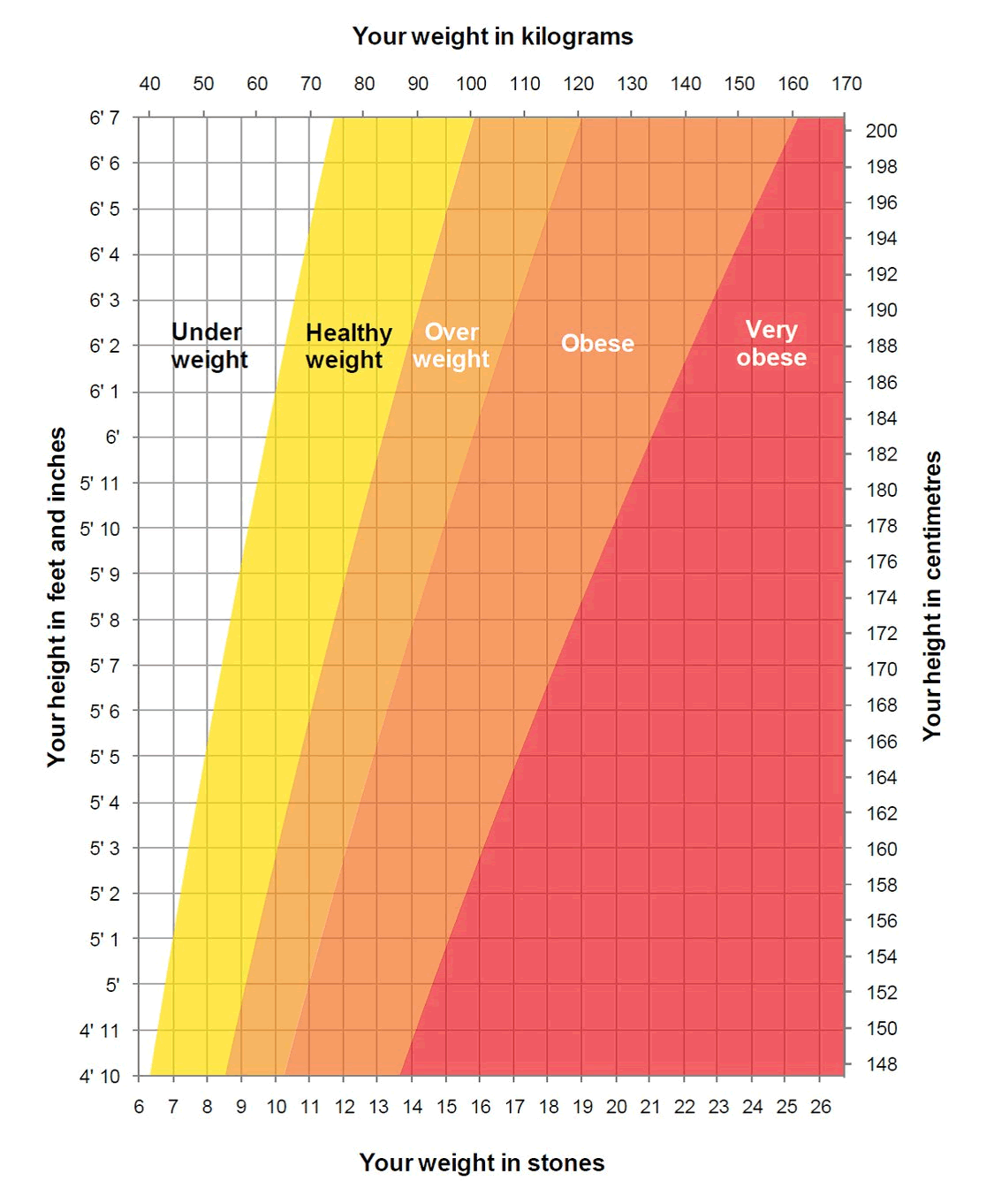
Your ideal weight?
Most people know they have a weight issue or some extra fat. But it doesn't hurt to know some statistics to gauge where you really are. The classic measure is BMI, which is a formula based upon height and weight (divide your weight in kilograms by your height in metres, then divide the answer by your height again). BMI is is pretty good indicator of your dalliance with obesity, but it doesn't really look at where the fat resides. A better measure is your belly to height ratio, which has been statistically shown to be a way better indicator of a persons likelihood that they will develop a metabolic disease such as diabetes or heart disease.
The typical western style 'processed food diet' has caused an epidemic of obesity and metabolic diseases. The pharmaceutical and food industry have lobbied and bribed every government in the world to create the conditions to keep this epidemic raging. Let's take the example of diabetes. The NHS in the UK specifically recommends not skipping breakfast and eating small meals all day. It also recommends less fat and salt with an emphasis on meals based around foods with starchy carbs (bread, pasta, rice and potato). The NHS describes diabetes as "A lifelong condition that causes a person's blood sugar level to become too high" .....this is completely wrong. Diabetes, like most metabolic diseases, can be reversed with a good diet and a changed eating frequency.
Belly to height ratio
There is a simple test that predicts your risk for developing diseases linked to excessive insulin levels, such as type 2 diabetes and heart disease. Belly circumference/ height = risk ratio
- Wrap a tape measure around you waist (horizontally). The spot to measure from is the top of your hip bones.
- Take a few breaths and take the measurement when you lightly exhale (at the end of a normal expiration). Don't suck in your tummy!
- Write down the result (in inches or centimetres) and divide by your height.
Ideally you should be at 0.5 or below:
- 0.49 = Females at risk.
- <=0.5 = Healthy male ratio
- 0.51 = BMI 25 equivalent.
- 0.53 = Males at risk.
- 0.57 = BMI 30 equivalent, high risk probably obese.
- 0.58 = Substantial risk
- 0.63 = Morbidly obese.

Exercise and weight loss
Exercise has mostly been promoted as a way for people to lose weight and to improve cardiovascular health and physical fitness. Yet research has not found exercise to be an effective way to lose weight. An exercise study in 2001 (Queens University, Canada) showed that after 20 weeks of exercise, it had no correlation with weight loss. Exercise alone does not result in weight loss. Exercise does however make you gain lean muscle mass, but as muscle weighs more than fat, you may not lose much weight.
Long term regular exercise reduces insulin sensitivity and increases your daily resting energy requirement, which sets you up for longer term weight loss (IF YOU KEEP IT UP!!). The problem with using just exercising to lose weight is that it's very difficult to stick to most programmes, especially going to the gym. Gyms actually rely on people not going to make money, people pay the money and attendance declines after the initial honeymoon period.
The problem with conventional gyms is that it takes time and effort to go there. If you factor in travel time, changing, socialising and ineffective programmes, you get a small result for the time and money invested. But gyms are great when used correctly because they have a huge array of weights and offer facilities such as pools and saunas, but a gym should just be part of you fitness programme. You are much better off simply walking, moving, stretching and performing some HIIT exercises daily.

For weight loss, we can use the "tortoise and the hare" analogy. The tortoise wins because it takes a steady methodical approach and never stops. The hare races off, only to falter shortly after. People who join a gym and start a calorie controlled diet after the Christmas period, almost always give up and pile the weight back on.
Exercise is good for weight loss only if it's done on a sustained basis. Exercise needs to become a daily habit.
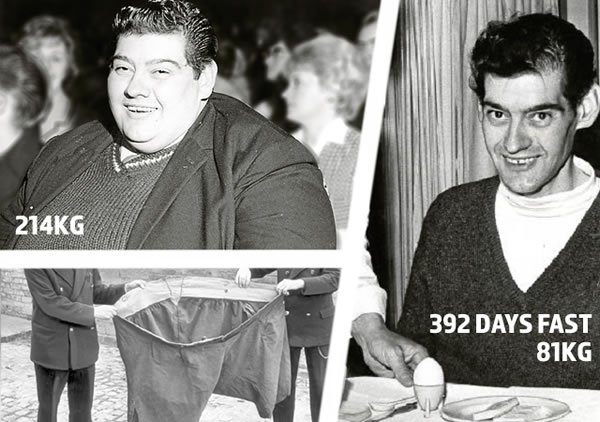
In 1965 Angus Barbieri decided to try fasting, days passed and he started to shed weight. So he kept going. He ate no food for 392 days and his body simply used his ample fat supply as energy. He drank tea, coffee and took vitamins. At the end of the fast he was medically well and he kept the weight off.
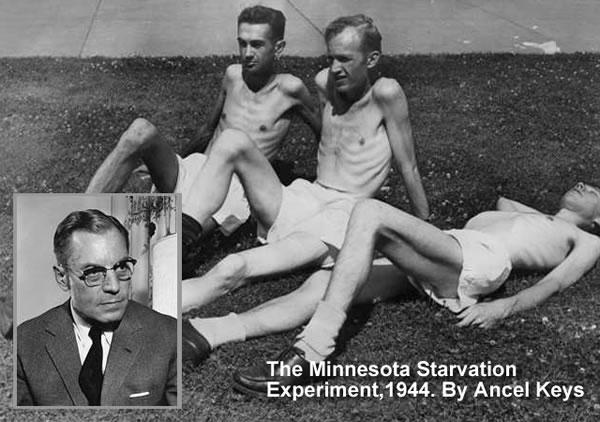
In 1944, a starvation study was carried out on 36 men for 13 months. They were fed 3200 calories per day for the first 3 months. This was then cut in half to 1600 calories per day, the results were a disaster. The men felt tired, irritable, bored and cold as their resting metabolic rate started to crash (the body responds to a colorific deficit by slowing things down). Sexual desire also evaporated. They craved food constantly and even resorted to stealing.
Which of the two examples above demonstrates starvation? It's clear that Angus wasn't starving at all. It was the 36 men on a low calorie diet that starved. Low calorie diets are a disaster and you pile the weight back on again. Ancel Keys also created the flawed 7 countries study in 1958 which started the "War on fatty foods", which in turn blamed cholesterol for heart disease.
Calorie restricted diets don't work
Most people try to lose weight with a combination of restricting calories and doing a little more exercise. Particularly restricting calories from fat. Over the last 40 years the weight loss food industry has boomed. So has the opportunity to do exercise via gyms and health clubs. So why hasn't the "Eat less & move more" model worked? Why have the western nations seen obesity rates rise year on year? The UK GP's database between 2004 and 2014 showed the success rates of eating less and doing more exercise covering millions of patients. Here were the results:
- The probability of an obese person achieving normal weight and keeping there: 0.6%
- The probability of a morbidly obese person achieving normal weight and keeping there: 0.1%
- 80% of people who lose 10% of their weight put it back on within a year.
However the medical and fitness industry has pushed the idea that reducing calories, lowering fat intake and doing more exercise is the only way to lose weight.

Why does just about every diet fail?
- Calorie restricting diets will slow your metabolism. You will feel cold and lack energy. Heart volume will shrink and heart rate will decrease. THIS IS THE KEY PROBLEM WITH STANDARD DIETS. Research dating back 100 years has shown that baseline metabolic rates can plummet when someone starts a calorie controlled diet. There are documented examples where the metabolism of people burning 3500 calories a day baseline dropped to half that after a period of calorie restriction. YOUR BODIES SURVIVAL MECHANISMS ARE INCREDIBLE!
- In the "Calories in - calories out" mode, calories out can vary wildly. It can go up to 3000 calories/day in some people and down to 1200 calories/day in others. It can also change depending on what we eat and when we eat.
- Calorie restricting diets play havoc with your hormonal health. Testosterone levels fall in men. Women can suffer reduced fertility and weaker bones. Calories don’t control metabolism, hormones do. Calories don’t determine what type of weight you will lose, hormones do. Calories have little influence over hunger, cravings, energy and mood, hormones do.
- Calorie restricting diets can cause nutrient deficiencies which can lead to major health problems.
- Calorie restricting diets tend to reduce muscle mass.
- Calorie restricting diets can reduce your immunity to disease.
- Some diets are hard to stick to. The keto diet is now all the rage, this involves eating 5-10% carbs and 60%+ fat. It gets some amazing results but the gains can quickly unravel if you cheat and return to carbs (eg a holiday, a cruise, Christmas etc).
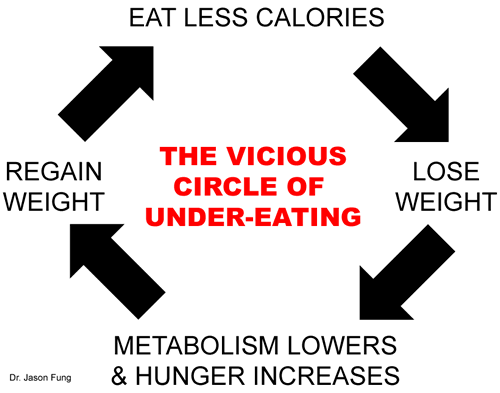
Think of it as your body going into a semi-starvation mode. Your body is happy being at the weight it is and it will fight against measures to change this. Your body likes to have reserves of energy (fat) and will change your metabolic rate accordingly to counteract any reductions. So if you finally end the period of lower calories, your body will soon add the weight back on thanks to its base calorie requirement being lower. This can lead to "yo-yo dieting".
Typically: You lose the fat and you gain it back!
How do you lose weight and keep it off?
- Don't count calories. As long as you are eating nutrient dense whole foods, you'll be fine and also feel full. You should avoid the "empty carbs" such as pasta, rice, breads and many processed foods)
- Get your insulin under control! You cannot burn fat if your body is spiking insulin all day long. When insulin is high it tells your cells to take in glucose and puts your body into fat storage mode.
- If you have constantly high insulin levels, triggered by constant eating throughout the day, it will be impossible to burn fat. Insulin is the fat storage hormone.
- Undertake fasting and intermittent fasting. Have a set window when you eat so that you are not eating all day long (avoid spiking insulin constantly) - a typical plan is to eat and drink in an 8 hour window. Intermittent fasting is so easy to do, just skip breakfast and try and push lunch out as much as possible.
- Do some daily exercises that you can stick to.
- Make it short and as intensive as possible (HIIT, is perfect). Exercise whilst fasted or semi-fasted.
- Walk as much as you can. Think about how you can tweak your day and add in some walking. Walking is great for the brain and idea development.
- Lift and carry things.
- Swim and cycle. They are both low impact full body exercises.
- Book an activity holiday (skiing, scuba diving, yoga weekend, hiking trip).
- Get a good nights sleep.
- Focus on foods that your hormonal health.
- Skip breakfast.
- Avoid foods that are labelled "low fat", they tend to be fibre deficient and contain extra sugar.
- Avoid "diet" foods such as weight watchers and super
- Eat nutrient dense foods, especially good fats.
- Eat foods that are wholesome and will fill you up (Satiety is the feeling of being full).
- Avoid hidden sugars in food and drinks, especially HFCS.
- Avoid processed foods. Use the switching technique, by changing the ingredients and the foods you eat for healthier alternatives.
- Try to be selective in restaurant meal choice.
- Avoid over-eating. Try and have some portion control, avoid buffets, avoid carvery style places ( go for quality over quantity).
- Avoid hoovering (eating the food of children or friends who can't eat everything).
- Avoid additives (processed food and some restaurant food)
- Focus on the essential electrolytes because your body is an electro-chemical system. Get plenty of Himalayan rock salt, magnesium, potassium, calcium, phosphorous and zinc.
- Cook at home.
-
Eat slowly (don't rush, chew, no distractions). Chewing makes digestion further down the line more efficient. The enzymes and bacteria in your saliva start to break down the food. Saliva contains several important enzymes such as amylase, lysozyme and lingual lipase. Lipase is an enzyme that breaks down dietary fats into smaller molecules called fatty acids and glycerol. So for people with a fat digestion issue such as gallbladder problems, chewing is very important.
-
Join a local food group. Source natural and local ingredients. Find good places to eat.
- Take a close look at your alcohol and drink consumption. Many people consume a high proportion of their daily calorific intake from drinks and alcohol (beers, wines, coffee, smoothies, sodas etc). Use the switching technique (switching from calorie laden drinks such as Jack coke, heavy beers, sugary drinks, iced tea, frappes, etc to much better alternatives).
- Keep hydrated. If you don't drink enough your body will start to retain water and bloat. When you don't get enough water, your body panics and holds on to it selfishly, as though you're in a desert.
- Do several small things daily in terms of increasing activity (and make this a habit).
- Try and walk more.
- Use the stairs.
- Do some chores such as house work and gardening.
- Play with the kids or grandchildren.
- Hear Jordan Peterson talk about fixing the small things in life.
- Have an full annual health check up. Men should specifically check their testosterone and estradiol levels.
- Look at your habits. Develop good habits and identify avoid bad ones.
- Focus on your gut health and your gut microbiome.
- Reduce and control stress. Control cortisol, avoid stressful people or situations,. Reduce mobile use (also TV, computers and gaming). Get a massage, take breaks, avoid bad routines. People in life that hold you back and moan all the time are called "boat anchors", get rid of them!
- Stretch (become more supple).
- Use breathing techniques, such as nose breathing and the Wim Hof method.
- Do monthly fitness benchmark testing. Monitor your strength and fitness.
- Review medications and target their removal (following medical advice).
- Stop recreational drugs use.
- Quit smoking or vaping.
- Quit diet drinks. They contain dangerous artificial sweeteners such as aspartame which badly affect gut health.
Calories, exercise and weight loss.
There are 180 calories in a pack of Starburst. A big bar of Snickers will set you back 280 calories. A large tube of Pringles contains over 800 calories. So it is very easy to consume 500 calories within a few minutes. How much exercise would you need to perform to work off 500 calories?
- 5 miles walking.
- 40 minutes of HIIT exercise.
- An hour of breast stroke swimming.
- 45 minutes of brisk cycling.
- 2 hours of lifting weights.
So as you can see, it's very difficult to out-train a bad diet. You must eat clean nutritious foods and stay away from processed high sugar foods.
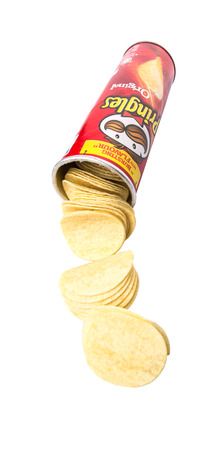
Avoid low fat diets
Fat contains cholesterol, which your body converts to steroidal hormones. This includes testosterone as well as estrogen. A diet in which less than 20% of the calories come from fat limits production of testosterone in men. You should consume healthy fats and enough fats to maintain hormone production. A diet high in MUFAs and SFAs, but low in PUFAs will promote testosterone production. Swap corn oil for virgin olive oil or coconut oil. MUFA = Monunsaturated fatty acids. SFA = Saturated fatty acids. PUFA = Polyunsaturated fatty acids.
The beer belly
If you are getting the majority of your calories from alcohol or sugary drinks you will start to expand at the waist. The same goes for snacking and eating all day. When your body takes in carbs, the glucose gets metabolised throughout the body and only 20% gets to the liver. When you drink alcohol, 80-90% goes immediately to the liver makes your liver work 4 times harder. Ethanol does not need insulin to get into the cells so it just diffuses into the liver cells.
Eating all day and night causes our pancreas to constantly pump out insulin. Not only do most people eat all day, they also eat highly processed foods, carbs and sugars that are easily digested (they have a high Glycemic Index). Visceral fat is technically excess intra-abdominal adipose tissue accumulation. It's also known as a “deep” fat that is stored further underneath the skin than “subcutaneous” belly fat. It's a form of gel-like fat that's wrapped around major organs, including the liver, pancreas and kidneys.
Many studies have pointed to an association between insulin resistance and visceral fat. resulting in the increased risk of a number of health problems including type 2 diabetes. Visceral fat secretes a protein called retinol-binding protein 4 (RBP4) which has been shown to increase resistance to insulin.
Beer belly creation
Fructose is processed exclusively in the liver and alcohol is 80% processed in the same manner. When you consume sugars and alcohol you typically have blood sugar levels and glycogen storage that are at their limits, so the liver has only one choice and that is to make fat via lipogenesis (lipo means fat and genesis means making). The fatty acids produced by the liver are delivered around the body via the blood. But much of the fat ends up stored in fat tissue, particularly in visceral fat around your abdominal organs. This leads to the creation of a beer belly.
- Alcohol is converted to acetaldehyde which is pretty toxic to the body, this is immediately converted into acetyl-CoA in the liver. Some of this is burnt as energy in the cell mitochondria, but a good portion has to be converted into fat.
- Fructose (the bad sugar) also follows a similar pathway and will lead to fat creation.
- Probably the worst combination of drink is a spirit and a sweet mixer (coke, tonic, sprite, orange juice etc). This is because the liver has to process both alcohol and fructose, whilst the body spikes insulin (due to the glucose in the soda) and goes into fat storage mode.
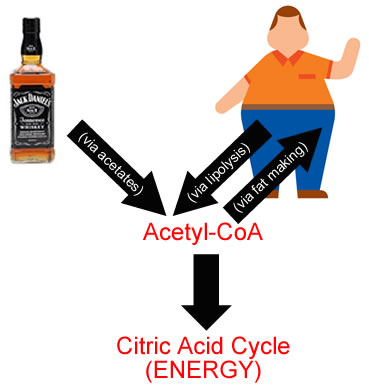
Post Exercise Fat Burning
An average person has just one heaped teaspoon of glucose in their bloodstream. The body breaks down or converts most carbohydrates into glucose. Excess glucose gets stored in your liver and muscles as a substance called glycogen. Your liver and muscles are essentially a "battery" for your body (glycogen is easily broken down into glucose). Stored glycogen can provides around 1700 calories or 500 grams of glycogen, which is enough for an hour of exercise.
If you perform hard exercise when there is no sugary foods or drinks in your digestive system, your bodies glycogen storage starts to deplete. When you stop exercising, DON'T GET A SUGAR HIT. Your body will start to "burn" fatty acids and fats as an energy source when glycogen is depleted. This is a process called Lipolysis where fat cells separate into free fatty acids and glycerol. Glycerol is easily converted into glucose for energy and glycogen for storage. This is a very efficient process when you are in a fasted state (during intermittent fasting). Your body will burn fat after exercising stops. It does this because it must replenish your glycogen stores. The only thing that will stop this is eating sugars and simple carbohydrates constantly.
The quickest way to lose fat is to exercise hard in short bursts AND not depend upon sugary foods and simple carbs as your main calories. If you implement intermittent fasting and HIIT exercises you will pressurise your glycogen storage and start tapping into fat reserves. Autophagy is activated following nutrient deprivation, some forms of exercise and different types of fasting. During fasting, when we don’t eat, our insulin levels go down and glucagon goes up. This enables the body to identify damaged cells and break them down preferentially. This process was first described in 1962 when researchers observed increased lysosomes (the part of cells that destroy things) in rat liver cells after glucagon was infused. The term, which is derived from the Greek auto (self) and phagein (to eat), meaning to eat oneself, was coined by Nobel Prize winning scientist Christian de Duve in 1963.
Removing Fat with ketosis
Ketosis is a normal metabolic process. When the body does not have enough glucose for energy and when glycogen stores are depleted, it burns stored fats instead. There are 2 ways to get into ketosis:
- Following the keto diet or other low-carb diets.
- Fasting or intermittent fasting.
Ketones role in the body were discovered over 100 years ago when scientists detected acetone in the breath which increased with strenuous exercise or fasting.
What is a fat?
There are many different kinds of fats, but each is a variation of the same chemical structure. All fats are derivatives of fatty acids and glycerol, called glycerides. Many fats are triglycerides which are more complex glycerides based on the 3 carbons of glycerol. As you can see below, the body simply removes 3 water molecules to create the triglyceride.

Adipose tissue, or fat, is an anatomical term for loose connective tissue composed of adipocytes. Its main role is to store energy in the form of fat, although it also cushions and insulates the body. Brown adipose tissue is found in almost all mammals. White adipocytes contain a single lipid droplet, brown adipocytes contain numerous smaller droplets and a much higher number of (iron-containing) mitochondria, which gives brown adipose tissue its brown appearance.
Breaking down fats to give energy
There is so much nonsense on the Internet regarding ketosis and ketones. The body is quite capable of burning fats without the need to produce ketones, fatty acids are broken down throughout the body. So let's take a step back. All fats in the body are glycerides (glyceride = glycerol + fatty acids). When a fat breaks down, a long chain of carbon with an acidic part at the end is produced which is called a fatty acid. Fatty acids are bound to the protein albumin when they are transported in the blood. Fatty acids are ultimately oxidized by β-oxidation into acetyl-CoA (Coenzyme A combines with the fatty acid to produce the activated version).
Beta oxidation is a metabolic process involving multiple steps by which fatty acid molecules are broken down to produce energy. It happens in the mitochondria in our cells. Beta oxidation consists of breaking down long fatty acids (that have been converted to acyl-CoA chains) into progressively smaller fatty acetyl-CoA chains. This reaction releases a smaller acetyl-CoA molecule and the compounds called FADH2 and NADH. These three can then enter another metabolic process called citric acid cycle or Krebs cycle, in which ATP is produced to be used as energy. Beta oxidation goes on until the acetyl-CoA chain has been completely broken down (Imagine a long strip of paper being progressively cut by scissors).
The glycerol that is released from triglycerides after lipolysis directly enters the glycolysis pathway (Glycolysis is a series of reactions that and extract energy from glucose by splitting it into two three-carbon molecules called pyruvates). Because one triglyceride molecule yields three fatty acid molecules with as much as 16 or more carbons in each one, fat molecules yield lots of energy. When glucose levels are low, triglycerides can be converted into acetyl CoA molecules and used to generate ATP through aerobic respiration.
The liver turns acetyl CoA into ketones! (AcAc, 3HB and Acetone)
The cells of the liver perform the same function in that they can convert fatty acids into acetyl CoA. This is what happens to the acetyl CoA in the liver:
- Two acetyl CoA molecules are combined (condensed) into Acetoacetyl CoA.
- Another acetyl CoA is added to produce HMG-CoA.
- The HMG-CoA degrades down to acetylacetate (AcAc) which is a ketone body (HMG-CoA can also be reduced in the mevalonate cycle to create cholesterol. Cholesterol is needed for testosterone production and this is why testosterone production is boosted with a fatty diet and a state of ketosis).
- AcAc can break down into 3HB (this is reversible).
- AcAc can break down into Acetone. Acetone production is minor compared to the other 2 ketones.

For complete combustion of fatty acids to ATP plus carbon dioxide plus water, glucose is required to keep the citric acid cycle running. If glucose is not available, acetyl coenzyme A is converted to molecules called ketone bodies. The fat-derived energy (ketone bodies) generated in the liver enter the blood stream and are used by other organs, such as the brain, heart, kidney cortex and skeletal muscle. Ketone bodies are particularly important for the brain which has no other substantial non-glucose-derived energy source. The two main ketone bodies are acetoacetate (AcAc), 3-hydroxybutyrate (3HB) and acetone. Ketone bodies are always present in the blood and their levels increase during fasting and prolonged exercise. After an over-night fast, ketone bodies supply 2–6% of the body's energy requirements, while they supply 30–40% of the energy needs after a 3-day fast. When they build up in the blood they spill over into the urine. The presence of elevated ketone bodies in the blood is termed ketosis and the presence of ketone bodies in the urine is called ketonuria. The body can also rid itself of acetone through the lungs which gives the breath a fruity smell.
All fat within the body has a glycerol backbone within the molecules, your body can break down fats into glycerol which can be broken down further into glycogen and glucose. Even if your body is fasting for days, it is still able to produce glucose from fat. We can survive without eating carbs and just ingesting protein and fats. Your body can make as much glucose as it needs, just by guzzling fat, whether it be stored or ingested. Your brain and cognitive functions are quite capable of running with a zero carbohydrate intake.
Ketolysis turns the ketones into fuel
Ketolysis is the process by which ketone bodies produced in the liver are converted (in non-liver tissues), into acetyl CoA which, on complete oxidation via the tricarboxylic acid cycle and oxidative phosphorylation, provides energy. Ketolysis occurs in the mitochondria of many organs.
Much of human history involves a search for food, with long periods of prolonged hunger when food was not available. Human metabolism thus developed mechanisms to cope with starvation. The use of stored fat reserves and their conversion to ketone bodies as a source of energy surely played a dominant role in the survival of the human species. The ability of ketone bodies to maintain life through their capacity to supply fuels, maintain electrolyte conservation, promote gluconeogenesis, and maintain acid–base balance during starvation has diminished in significance since humans now graze all day on simple carbs.
Your brain requires glucose as a fuel. Glucose is virtually the sole fuel for the human brain, except during ketosis. The brain lacks fuel stores and hence requires a continuous supply of glucose. It consumes about 120g daily, which corresponds to an energy input of about 420 calories. The backup is ketone bodies that the liver derives primarily from fatty acids in your diet or body fat.
Insulin Prevents Lipolysis
Lipogenesis is the process that converts sugars to fats, which are subsequently deposited and stored in fat tissue. Lipolysis is the process of fat breakdown, typically to generate energy. These two metabolic activities are controlled by hormones. Insulin is particularly important in fat metabolism and lipolysis.
When your blood sugar level rises, insulin drives glucose into your cells to regulate blood sugar. But it also inhibits the secretion of glucagon, the pancreas releases glucagon when the concentration of glucose in the bloodstream falls too low. Glucagon causes the liver to convert stored glycogen into glucose. When insulin is present, you cannot burn fat..... so insulin promotes lipogenesis and effectively prevents lipolysis.
Intermittent fasting also encourages the state of ketosis because the body is not being inundated with constant sugar hits and insulin spikes. If you want to understand fat burning and ketosis, you need some appreciation of how fats degrades into ketones within the body.
When your blood has a low concentration of glucose for a sufficient period of time, the fat production process is reversed. Your pancreas releases a protein and glycogen is depleted. Other hormones (epinephrine, cortisol, testosterone, etc) are introduced into your system, and lipisd in the white fat cells (that house our triglycerides) are pulled from the fat cells and converted into Acetyl Co-A, which is the key precursor for the process your body uses to generate “energy” (i.e. ATP) for your cells.
Triglycerides and cholesterol are fats that come from your diet or are made in your body. Triglycerides are stored mainly within lipid droplets in cells of your fatty tissue, also called adipose tissue. However, triglycerides can inappropriately accumulate in organs such as your liver and muscle. Cholesterol is also stored within lipid droplets in your cells, but its primary function is to contribute to the structure of the outer membrane of every cell in your body. Triglycerides can be mobilized from storage sites and burned for fuel, whereas cholesterol is metabolized to bile acids, sex hormones and vitamin D.
Triglyceride Mobilization
Triglycerides are primarily mobilized through stimulation of cells in your adipose tissue by hormones, which include epinephrine, commonly known as adrenaline. Hormone stimulation causes the breakdown of triglycerides to fatty acids, which are released into your blood and picked up by tissues such as your heart, muscles and liver. Triglycerides are usually broken down when there is a relative deficiency of glucose reaching your body’s tissues and energy is needed. This can occur during overnight fasting, during prolonged intense exercise or if you have diabetes and glucose uptake into your tissues is not functioning properly.
Ketone bodies can be anti-inflammatory. Some kinds of cancer cells are unable to useketone bodies, as they do not have the necessary enzymes to engage in ketolysis. It has been proposed that actively engage in behaviors that promote ketogenesis and could help manage the effects of some cancers.
Common eating patterns
The standard diet is typically quite high carb' and relatively low fat. The standard American diet (SAD) follows this patter but contains high levels of refined carbs.

Ketogenic diets are high fat and very low carbohydrate diets. Nutritional ketosis (NK) comes from dieting. Ketosis can also happen during fasting periods, which is known as fasting ketosis (FK). There are problems with the nutritional ketosis only approach:
- NK requires calorie counting to ensure you are eating very little carbs and tons of fat.
- The Keto diet is trendy and all the rage at the moment.
- NK requires a BIG change in eating patterns and it's very easy get quick results and have them reversed by eating carbs again.
- The standard model for the keto diet is only 5% carbohydrate which equates to 100-150 calories per day. This is very hard to achieve over time. 1g of carbs deliver about 4 calories, so we are talking less than a small snickers bar a day or about 5 after eight mints. A diet is only as good as a persons ability to stick with it.
- Metabolism can slow down (your body thinks it's starving and will slow things down accordingly).
- The almost total avoidance of carbs on keto diets can cause issues with hormonal health. Studies have shown that the thyroid in particular can suffer.
- NK is similar the the Atkins diet which was once all the rage.
- People find it hard to maintain muscle mass on a keto diet, let alone add muscle mass.
- NK generates oxygen radicals and cause lipid peroxidation. Lipid peroxidation and the generation of oxygen radicals may play a role in vascular disease in diabetes.
The best diet is not to diet at all..... just eat clean food in an eating window, do occasional fasts and remove processed carbs from your diet where possible.
